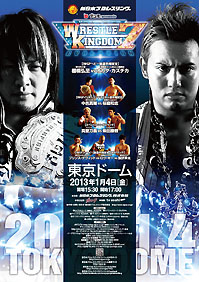The January 4 Tokyo Dome Show is a professional wrestling event produced annually on January 4 in the Tokyo Dome by New Japan Pro-Wrestling (NJPW), a Japan-based professional wrestling promotion. NJPW has promoted events in the venue every January 4 since Super Warriors in Tokyo Dome in 1992.

Katsuyori Shibata is a Japanese professional wrestler, mixed martial artist and professional wrestling trainer currently signed to New Japan Pro-Wrestling (NJPW) and All Elite Wrestling (AEW). He also makes appearances for AEW's sister promotion Ring of Honor (ROH), where he is a former ROH Pure Champion. In professional wrestling, he is known for his hard hitting offense. He spent most of his career with NJPW as both a wrestler and trainer. In NJPW, he is a former three-time NEVER Openweight Champion, a one-time IWGP Tag Team Champion, and the winner of the 2017 New Japan Cup. He is also a former holder of Revolution Pro Wrestling's RPW British Heavyweight Championship. From March 2018 to July 2023, Shibata served as the head coach of NJPW's dojo in Los Angeles.

Chaos is a professional wrestling stable, primarily performing in the New Japan Pro-Wrestling (NJPW) promotion and All Elite Wrestling (AEW). The group was formed in 2009, when nearly all the members of the Great Bash Heel (G.B.H) stable turned on leader Togi Makabe and reformed under new leader Shinsuke Nakamura. Soon after, the new group was named Chaos, with Nakamura as the leader. As the leader of Chaos, Nakamura was one of NJPW's top wrestlers, winning the IWGP Heavyweight Championship and the IWGP Intercontinental Championship as well as the 2011 G1 Climax and the 2014 New Japan Cup.

Wrestle Kingdom VI in Tokyo Dome was a professional wrestling pay-per-view (PPV) event produced by the New Japan Pro-Wrestling (NJPW) promotion, which took place at the Tokyo Dome in Tokyo, Japan on January 4, 2012. It was the 21st January 4 Tokyo Dome Show and the sixth held under the "Wrestle Kingdom" name. This was the final Wrestle Kingdom where a Roman numeral was used as part of the event's name. The event featured twelve matches, three of which were contested for championships.
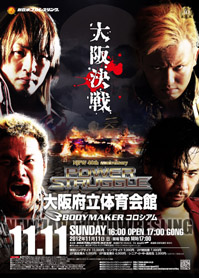
Power Struggle (2012) was a professional wrestling pay-per-view (PPV) event promoted by New Japan Pro-Wrestling (NJPW). The event took place on November 11, 2012, in Osaka, Osaka, at the Bodymaker Colosseum and featured nine matches, five of which were contested for championships. It was the second event under the Power Struggle name.

Back to the Yokohama Arena was a professional wrestling pay-per-view (PPV) event promoted by New Japan Pro-Wrestling (NJPW). The event took take place on May 25, 2014, at the Yokohama Arena in Yokohama, Kanagawa and marked NJPW's first event at the arena in eleven years.

King of Pro-Wrestling (2014) was a professional wrestling pay-per-view (PPV) event promoted by New Japan Pro-Wrestling (NJPW). The event took place on October 13, 2014, in Tokyo at Ryōgoku Kokugikan and featured ten matches, six of which were contested for championships. It was the third event under the King of Pro-Wrestling name.
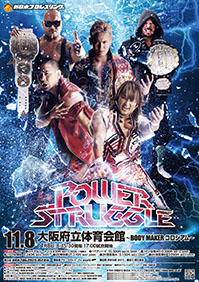
Power Struggle (2014) was a professional wrestling pay-per-view (PPV) event promoted by New Japan Pro-Wrestling (NJPW). The event took place on November 8, 2014, in Osaka, Osaka, at the Bodymaker Colosseum.

Wrestle Kingdom 9 in Tokyo Dome was a professional wrestling pay-per-view event produced by the New Japan Pro-Wrestling (NJPW) promotion, which took place at the Tokyo Dome in Tokyo, Japan on January 4, 2015. It was the 24th January 4 Tokyo Dome Show and the first event on the 2015 NJPW schedule. The event featured ten professional wrestling matches and one pre-show match, six of which were for championships.

Wrestle Kingdom 8 in Tokyo Dome was a professional wrestling pay-per-view (PPV) event produced by the New Japan Pro-Wrestling (NJPW) promotion, which took place at the Tokyo Dome in Tokyo, Japan on January 4, 2014. It was the 23rd January 4 Tokyo Dome Show and the eighth held under the "Wrestle Kingdom" name. Like the previous year, the event aired worldwide on internet pay-per-view (iPPV).

Wrestle Kingdom III in Tokyo Dome was a professional wrestling pay-per-view (PPV) event produced by the New Japan Pro-Wrestling (NJPW) promotion, which took place at the Tokyo Dome in Tokyo, Japan on January 4, 2009. It was the 18th January 4 Tokyo Dome Show and the third held under the "Wrestle Kingdom" name. The event featured eleven matches, five of which were contested for championships.
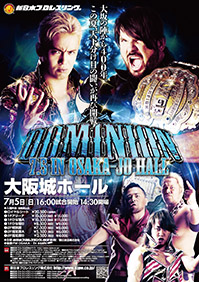
Dominion 7.5 in Osaka-jo Hall was a professional wrestling pay-per-view (PPV) event promoted by New Japan Pro-Wrestling (NJPW). The event took place on July 5, 2015, in Osaka, Osaka, at the Osaka-jō Hall. The event featured ten matches with all six of NJPW's championships on the line, main evented by an IWGP Heavyweight Championship match between champion A.J. Styles and challenger Kazuchika Okada.

King of Pro-Wrestling (2015) was a professional wrestling pay-per-view (PPV) event promoted by New Japan Pro-Wrestling (NJPW). The event took place on October 12, 2015, in Tokyo at Ryōgoku Kokugikan. The main event saw Kazuchika Okada defending the IWGP Heavyweight Championship against A.J. Styles. All in all, the event featured nine matches, four of which were contested for championships.

Power Struggle (2015) was a professional wrestling pay-per-view (PPV) event promoted by New Japan Pro-Wrestling (NJPW). The event took place on November 7, 2015, in Osaka, Osaka, at the Osaka Prefectural Gymnasium and featured nine matches, two of which were contested for championships as well as the finals of the 2015 Super Jr. Tag Tournament.

Wrestle Kingdom 10 in Tokyo Dome was a professional wrestling pay-per-view (PPV) event promoted by New Japan Pro-Wrestling (NJPW). The event took place on January 4, 2016, in Tokyo, Japan, at the Tokyo Dome. It was the 25th January 4 Tokyo Dome Show. The event featured ten matches and was main evented by Kazuchika Okada defending the IWGP Heavyweight Championship against Hiroshi Tanahashi.
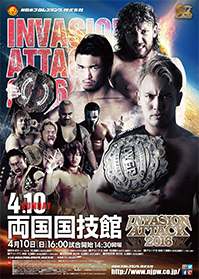
Invasion Attack 2016 was a professional wrestling pay-per-view (PPV) event promoted by New Japan Pro-Wrestling (NJPW). The event took place on April 10, 2016, in Tokyo at Ryōgoku Kokugikan, and featured nine matches, six of which were contested for championships. The main event saw the winner of the 2016 New Japan Cup, Tetsuya Naito defeat Kazuchika Okada for the IWGP Heavyweight Championship.
Wrestling Hinokuni is a professional wrestling event promoted by New Japan Pro-Wrestling (NJPW).
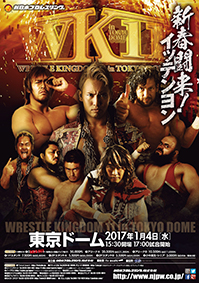
Wrestle Kingdom 11 in Tokyo Dome was a professional wrestling event promoted by New Japan Pro-Wrestling (NJPW). The event took place on January 4, 2017, at the Tokyo Dome in Tokyo, Japan. It was the 26th January 4 Tokyo Dome Show.
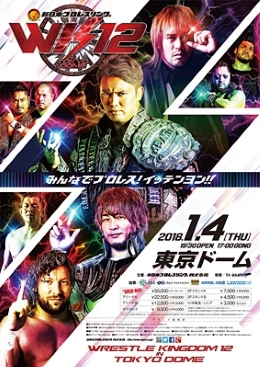
Wrestle Kingdom 12 in Tokyo Dome was a professional wrestling event promoted by New Japan Pro-Wrestling (NJPW). The event took place on January 4, 2018, at the Tokyo Dome in Tokyo, Japan. It was the 27th January 4 Tokyo Dome Show, which is NJPW's biggest annual event and has been called "the largest wrestling show in the world outside of the United States" and the "Japanese equivalent to the Super Bowl".

Wrestle Kingdom in Tokyo Dome was a professional wrestling pay-per-view (PPV) event co-produced by the New Japan Pro-Wrestling (NJPW) and All Japan Pro Wrestling (AJPW) promotions, which took place at the Tokyo Dome in Tokyo, Japan on January 4, 2007. It was the 16th January 4 Tokyo Dome Show and the first held under the new "Wrestle Kingdom" name.
